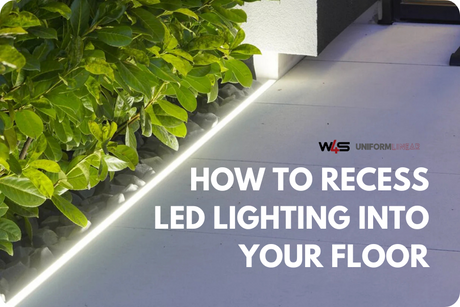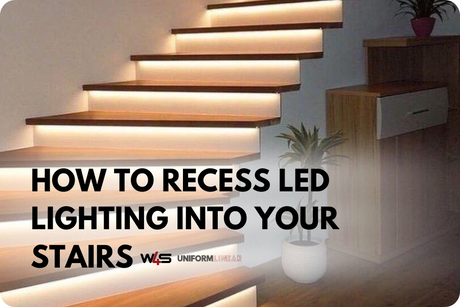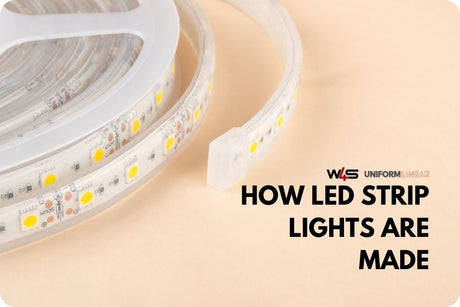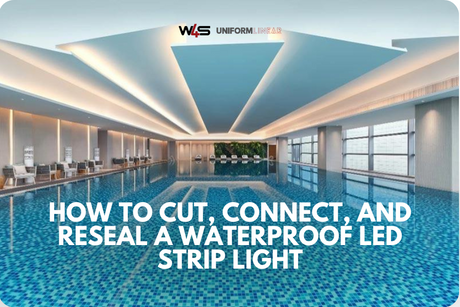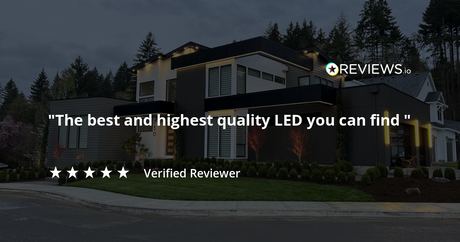Ready to transform your space with the magic of LED strip lights?
Whether you’re designing a cozy haven, adding a touch of modern elegance, or creating a vibrant party atmosphere, LED strip lights are your ticket to an illuminated masterpiece. Their popularity is no surprise—they’re versatile, energy-efficient, and incredibly easy to work with.
In this guide, we’ll walk you through every step of the installation process, ensuring your project is as seamless as it is exciting.
Benefits of Installing LED Strip Lights

Before we get into installing LED strip lights, let's first understand the benefits:
Aesthetics
Transform your home or workspace into a visually captivating environment with LED strip lighting. These lights can be used to create vibrant or subtle lighting effects, perfect for accent lighting installations or setting the mood in any room.
Whether you’re aiming for modern elegance or cozy ambient lighting, LED strips provide endless creative possibilities.
Energy Efficiency
LED lights consume significantly less energy compared to traditional lighting solutions, making them an eco-friendly choice for any lighting project.
Their low power consumption translates to reduced electricity bills, allowing you to enjoy beautiful lighting without worrying about energy costs. When combined with a dimmer switch, you can further enhance energy savings by adjusting the brightness to suit your needs.
Versatility
LED strip lighting is suitable for a wide range of applications. Use them as cabinet LED strip lights in kitchens for better task lighting or as accent lighting in living rooms to highlight architectural features.
They are also ideal for outdoor spaces, where weather-resistant LED strips can illuminate patios or garden pathways. With options like color-changing lights and RGB LED light strips, you can customize your lighting to match any theme or occasion.
LED strip lights offer a simple installation process, and their adhesive strips make mounting easy on most surfaces.
Additionally, the availability of solderless connectors and aluminum channels ensures that you can achieve a polished and professional look. Whether you’re planning a large-scale lighting project or looking for individual strip lights to enhance specific areas, LED strip lighting is a versatile and practical choice.
Materials Needed
Before starting your lighting project, gather the following materials:
- LED strip lights
- Power supply
- Adhesive strips or mounting brackets (most strips come with self-adhesive backing)
- Scissors or a cutting tool (for adjustable lengths)
- Measuring tape
- Cleaning supplies (e.g., alcohol wipes or a clean cloth)
- LED channels for a polished finish
- Strip connectors for seamless connections
- Wire strippers (if needed)
- Electrical tape for securing connections
- Optional: dimmer switch, remote controls, or Bluetooth-enabled LED controllers for added functionality
Planning Your Installation

Here are some things to consider before installation:
Choosing the Right Location
Selecting the right location for your LED strip lighting is crucial for achieving the desired effect. Popular placement ideas include:
- Under-Cabinet Lighting: Perfect for kitchens, under-cabinet LED strip lights provide focused illumination for countertops, enhancing both functionality and aesthetics.
- Behind Televisions: Create a cinematic ambient lighting experience that reduces eye strain and adds a modern touch to your living room.
- Around Mirrors: Add a chic effect to bathrooms or dressing areas, making spaces feel larger and more luxurious.
- Along Staircases: Combine safety and aesthetics by installing light strips along stair edges to illuminate steps.
- Outdoor Spaces: Highlight garden paths, patios, or decks with weather-resistant LED strip lights to elevate your outdoor ambiance.
Measuring and Preparing
- Use a tape measure to determine the length of LED strips needed for your space.
- Decide on a power source and ensure it’s easily accessible.
- Plan the routing of the power supply to avoid visible wires.
Preparing the Surface
Cleaning and Prepping
To ensure proper adhesion:
- Clean the installation area with alcohol wipes or a clean cloth to remove dust and grease. Proper cleaning helps the adhesive last longer by ensuring a smooth and secure bond to the surface.
- Allow the surface to dry completely before proceeding.
Additional Tips
- Smooth surfaces work best for adhesive strips.
- For uneven areas, consider using LED mounting channels.
Cutting the LED Strip Lights

If your light strip is longer than required, you can trim it to fit. Here’s how:
- Identify the designated cutting points on the strip (usually marked by copper dots).
- Use scissors or a cutting tool to make a clean cut at these points.
- Avoid cutting outside the marked areas to prevent damaging the circuit.
For a detailed demonstration, check out our video on cutting LED strip lights.
Attaching the LED Strip Lights
Step-by-Step Guide
- Peel off the backing from the adhesive strip.
- Carefully align the LED strip along the planned path.
- Press firmly to secure it in place.
Tips for Perfect Placement
- Use sided tape for additional reinforcement if the adhesive weakens.
- Install LED channels for a more polished and durable look.
Connecting Your Controller
To add functionality like dimming or color changes:
- Attach the LED strips to a controller using solderless connectors.
- Connect the controller to the power supply.
- Test the system with remote controls or app controls.
Connecting the Power Supply

Instructions
- Match the positive wires (usually marked red) and negative wires (black) from the LED strip to the power supply.
- Secure the connections using a wire nut or electrical tape.
- Plug in the power supply to a nearby outlet.
For a deeper dive, check out our article on wiring LED strip lights.
Troubleshooting Common Issues
- If the lights don’t turn on, check for loose connections.
- Ensure the polarity of the wires matches the power supply.
- Inspect for voltage drops in longer strips.
Testing the Installation
Turn on the power supply to test your LED strip lighting. Ensure all sections light up evenly. If any part doesn’t work, recheck the connections and consult our troubleshooting guide.
Finishing Touches
To enhance the ambiance of your space, consider adding a dimmer switch to your LED lights. This allows you to adjust the brightness, saving energy and extending the lifespan of your lights. Also, experimenting with RGB LED light strips can introduce color-changing effects, helping you create various moods and atmospheres tailored to your needs.
Conclusion
Installing LED strip lights is a simple installation process that enhances both the functionality and aesthetics of your space. With careful planning and execution, you can transform any room into a well-lit haven.
Don’t hesitate to explore creative configurations and accessories like dimmers or remote controls to improve your lighting project.
FAQs
What are the benefits of using LED strip lighting?
LED strips are energy-efficient, versatile, and perfect for creating ambient or accent lighting.
Can I install LED strip lights on curved surfaces?
Yes, but using adhesive strips or mounting channels is recommended for better adherence.
How do I prevent voltage drops in longer LED strips?
Use a constant voltage supply or connect the strips in separate circuits to ensure consistent brightness.
What’s the best way to connect LED strips without soldering?
Use solderless connectors for quick and reliable connections.
Are LED strip lights waterproof?
Some models are designed for outdoor use. Check the IP rating before installation.



